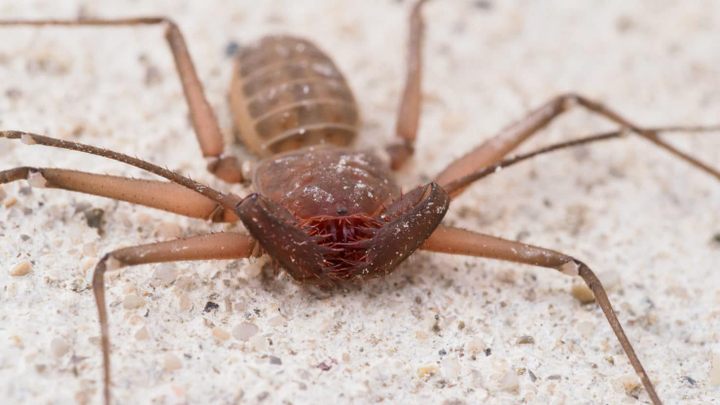
Making Sense of the Great Whip Spider Boom
Studying the arachnids reveals as much about the structure of science as it does about the creatures.
This story was originally published in Undark and appears here as part of the Climate Desk collaboration.
About 18 years ago, Andrea Colla got an unusual request. Would he come survey the fauna of a Nazi air-raid shelter? Even by entomologists’ standards, the task was weird. This warren lay under the Italian city of Trieste, and it was built in secret between 1943 and 1944 at the orders of a war criminal who wanted a subterranean escape route from his villa. Eventually, the tunnels had become a museum, managed by the cave enthusiasts of the Trieste Alpine Club; they wanted to know who else was hanging out down there, besides tourists, school groups, and them.
One afternoon, after finishing his work at Trieste’s natural history museum, Colla went down with a headlamp to poke around and set some traps. For bait, he used Gorgonzola because, he said, it’s “better if it is a cheese that smells a lot.”
Colla is a man of cave insects. Like many Triestinos, he’d grown up spelunking: Instead of going to the cinema, he and his tobacconist dad spidered down ropes and followed waterworn paths through limestone—a hobby that became part of Colla’s job. Aboveground Europe, he believed, had few creatures left uncatalogued. To describe and classify new species—advancing the science of taxonomy, one bug at a time—he looked to the isolated spots he’d explored as a child. “In caves,” he said, “there are still surprises.”
But Colla didn’t expect anything too surprising from a bunker. When he went to check his traps, he was right: Not much beyond standard basement crickets and spiders.
So he was taken aback in 2019 when one of the air-raid tunnel guides sent him a snapshot of a cartoonishly evil-looking creature—like a cross between a tarantula and a crab, with skin-crawlingly long legs, barbed pincers, and a brownish coat of armor. To Colla, it was unmistakable. This was a harmless arachnid called an amblypygid, sometimes known as a whip spider or tailless whip scorpion, which was neither spider nor scorpion. And it was not supposed to be in Italy at all.

Amblypygids were popping up elsewhere, too. In 2018, an undergraduate in suburban Athens found a few scuttling through his bathroom and kitchen—now he’s credited with uncovering the species’ presence in continental Europe. In 2019, there was the first confirmed record of amblypygids in Jordan, also in a bathroom. In both cases, the person who helped identify the critters was Brazilian arachnologist Gustavo de Miranda. And he’s just outdone himself: Last year he submitted a paper, the publication of which is forthcoming, describing 33 new amblypygid species, one of which has only ever been seen in the pipes and storage sheds of a Rio de Janeiro museum.
Such findings are more often pictured in treacherous caves and tangles of jungle, or oozing unseen in the darkest patches of ocean. The great whip spider boom shows that’s only part of the story. On the one hand, scientists find it heartening: the planet seething with so much undiscovered life that it’s lurking not only in the backcountry but in basements and bathrooms. But the fact that these species haven’t yet been described has more to do with scientific fashion than with the creatures themselves. Though it might seem abstract, what does or does not get attention in the pages of, say, the Journal of Arachnology, can affect the natural world.
As de Miranda put it, “We can only preserve what we know.” His hope is that by filling in those gaps, he can map which species live where, how humans have moved them around—and prevent any more from going extinct before researchers have registered their existence.
When biologists talk about whip spiders, they invariably categorize them as a minor order of arachnids—meaning a branch that encompasses fewer species than spiders or scorpions. But minor order also has a whiff of neglect. Among eight-legged creatures, amblypygids are the forgotten stepchildren—footnotes in the natural history of the creepy-crawlies. Though amblypygids range in size, some small as a thumbnail, others wide as a pint glass, they tend to be brownish and drab. Some are sold as pets, and one even had a cameo in a Harry Potter film. But even among arachnophiles, they’re only just starting to creep toward the mainstream. “I used to be able to say, ‘I’m one of three people in the world who studies amblypygids,’” said Eileen Hebets, an arachnologist at the University of Nebraska–Lincoln. “Now I don’t even know how many there are.”
To Hebets, the reason is simple: In science, attention begets attention. What began as a graduate student’s fringe obsession could become the focus of a whole lab, eventually seeding others in its wake. Hebets saw her first live amblypygid in 1998, during her PhD, the night she arrived in Costa Rica for a tropical ecology course. She couldn’t stop looking at the creature’s front legs. These are the whips that give whip spiders their name—elongated, antenna-like—and they were sweeping around in all directions, as if piecing together a picture of the world. Even now, over 20 years later, she isn’t sure how to describe the grace of that movement. It was like a blade of grass fluttering in the wind, if a blade of grass were purposeful. It was like an octopus tentacle. “I just immediately fell in love,” she said.
Hebets read whatever she could about amblypygids, but there wasn’t much. The only papers that might tell her how to distinguish males from females were in German; she had to ask a friend for translations. She wanted to untangle what those wispy legs were sensing. Painstakingly, she and others set up experiments to find out, blowing chemicals over the legs and tracking the resulting electrical jolts, daubing nail polish over the sensory hairs and watching how well the animal could still skulk its way home. What emerged over decades was a dazzling portrait: an invertebrate with super-powers. Some species are powdered with tiny structures that create a kind of diving bell, so they can bubble themselves with air and keep breathing in a flood.
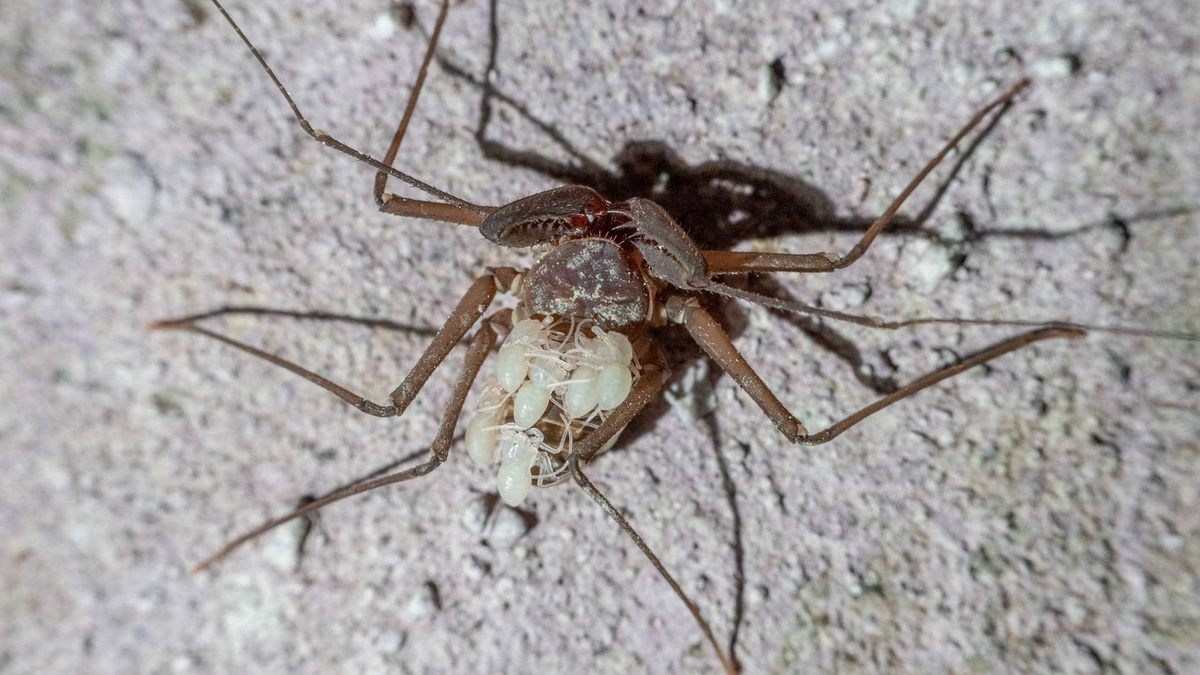
Yet as those observations trickled in, researchers were only just determining what exactly these things were and where they lived. Even as they learned more about the behavior of this or that species, the group’s taxonomy was still fuzzy at best. Mark Harvey, head of terrestrial zoology at the Western Australian Museum, keeps spreadsheets of the minor orders of arachnids—“I have what my colleagues call ‘cataloguers’ disease,’” he joked—and his data showed an amblypygid explosion. “At the moment, there are 216 species of whip spiders recognized from around the world, and half of those—106 of those—have been described since 1994,” he said in January. “That’s a massive increase.”
De Miranda came of age around the middle of that curve. He’d grown up in Porto Velho, Brazil, on the edge of the Amazon. His father was an agronomist, spending weekdays warning farmers about banana blight and weekends showing Gustavo how to use complex, branching charts to identify ants and beetles. When de Miranda went away to college in Rio de Janeiro and learned about the minor orders of arachnids, he saw a weird discrepancy. They were so mysterious, but so easy to find. He could unearth plenty of short-tailed whip scorpions, even in Brazil’s second biggest city.
Amblypygids became his version of Colla’s caves. It was hard to find a lab at first. Once he did, though, he became prolific contributor to Harvey’s spreadsheets, describing new species everywhere from Timor-Leste to Belize. Glancing at his oeuvre, it may seem that there’s an inexorable army of amblypygids on the move, but that isn’t it. Mostly, de Miranda said, “it’s just the lack of people looking.”
Colla had been looking, though—not for amblypygids specifically, but for whatever was living in the Italian bunker in 2003. He wasn’t the only one. Trieste sits near the top of Italy’s boot, between the Slovenian border and the Adriatic Sea. To the east lies a plateau so riddled with galleries and grottoes that Colla calls it the birthplace of cave science. The claim is arguable, but the region’s longstanding obsession with caves isn’t: Between 1880 and 1920, some 2,000 local caves were described, and members of the Trieste Alpine Club have been exploring everything from mushrooms to caverns to historical sites since 1945. With so many people popping into the natural tunnels outside of town—and the human ones beneath—it seemed unlikely that the amblypygids had simply gone unnoticed.
The whip spider research world is small, and de Miranda had gotten involved with Colla’s study soon after the club had seen the first amblypygid. This wasn’t a new species. It was, in fact, widespread, a denizen of Jerusalem’s sewers and Turkish caves — a species he’d recently helped document for the first time in Jordan, where it was expected, and in mainland Greece, where it was not. Amblypygids are tropical and subtropical, and Jordan has the right climate, the kind of place where no one had bothered to record the species until recently, but where the bug was presumed to be. Athens, though, is chillier, and de Miranda wasn’t sure whether the population there was native or introduced. But Trieste is over 1,000 miles to the northwest. Hebets, who wasn’t involved in the project, had heard rumors of unreported amblypygids in Italy. To de Miranda though, this particular region seemed improbably cold.
The bunker is known as Kleine Berlin—“Little Berlin”—a complex of four different shelters, three built for Italian civilians, one for German soldiers. Inside, Colla could see the earth reclaiming part of the past, wartime graffiti in some places, stalactites in others, here a toilet, there the lava-like overlay of minerals on the wall and the floor. The whip spiders were found on the Nazi side, in a wet, 260-foot-long tunnel near the courthouse, littered with rusted relics and off-limits to tourists. There they were, clinging to the wall: Not just one amblypygid, but a whole population. He and his colleagues would count nine in total. Eventually, greenish babies appeared on an adult’s back, the little antenna-legs crisscrossing, de Miranda said, “like a noodle soup.”
But as far as the researchers could tell, the entire Trieste population was female. That meant they were likely reproducing without any males, using a strategy called parthenogenesis—Greek for “virgin birth.” It’s a trick seen in certain arachnids, insects, crustaceans, and even reptiles, laying viable eggs with no sex involved. Many—including these amblypygids, it seems—are versatile, sometimes mating, sometimes making babies solo.
The trigger for going one way or another can be environmental. “It could be a factor of density, where you reach a certain age—‘I haven’t run into any of the same species as me, I’m just going to start producing eggs,’” explained Mercedes Burns, an arachnologist at the University of Maryland, Baltimore County. How it works in amblypygids is still fuzzy, but in other creatures, the egg’s chromosomes doubles on their own or the egg undergoes a kind of faux-fertilization. Some of the cells involved in egg-development also contain chromosomes, and instead of being sloughed off as usual, they can act a little like sperm, providing the missing piece so the offspring has all the genetic material it needs. Generally, the maneuver is risky—one lousy curveball and the whole population might go bust—but handy for stowaways: A single female can go anywhere and found her own outpost of clones.
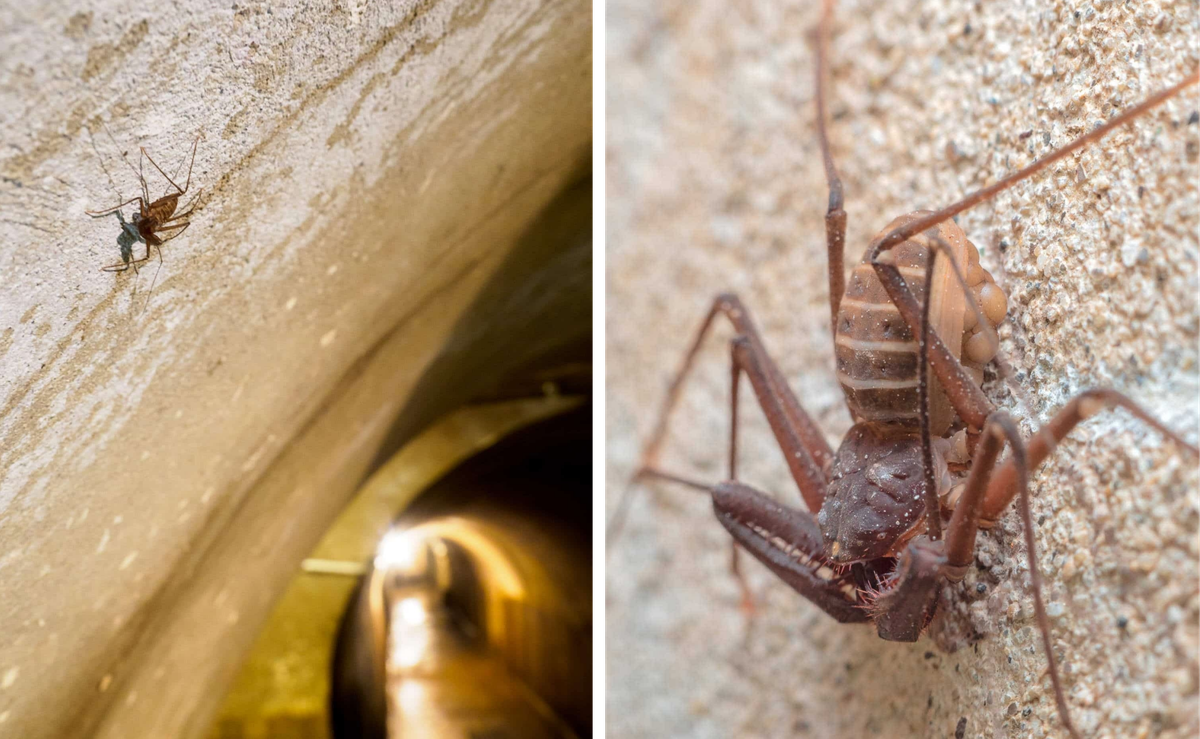
Someone must have unwittingly carried a single specimen into Trieste from elsewhere. From where, nobody knew. It wasn’t the kind of amblypygid kept as a pet, and every party working to solve the mystery had some tidbit that cast doubt on the origin story someone else proposed.
The pioneering whip spider might have wedged itself into some crevice on a ship—but as, arachnologist Filippo Castellucci, a PhD candidate who worked on the project with Colla, put it, “it seems less likely, because the harbor in Trieste is not that close.”
The members of the Trieste Alpine Club might have carried it in on some piece of caving equipment, but as Lucio Mircovich, one of the club’s board members, put it in an email to Undark, “The materials used in the expeditions to Greece have never been placed in the Kleine Berlin.”
“Could it have been brought by German soldiers 80 years ago?” Mircovich wrote. But Colla had scoured the complex’s different chambers over a decade ago; he’s pretty sure he’d have noticed an amblypygid.
Even this species, well-documented by whip spider standards, was a riddle. The answer might have been clearer if researchers knew more about where this bug lived in the first place. It was a mis-shelved book in a library that was only half-catalogued.
To other arachnologists, that’s hardly a shock. “The most common wolf spider in my yard is currently undescribed,” said Harvey, of the Western Australian Museum. “There’s still so much to learn about biodiversity, especially in tropical areas where, literally, there are new species in our backyards.”
The discovery of those that aren’t yet known can emerge from efforts to map those that are. A few years ago, de Miranda helped examine whip spiders from three caves in Israel, two yielding the same species found in Jordan, Turkey, and Greece, and the third yielding something completely new, with weaker eyes and more pincer-spines. But such surveys are spotty, too. As Gwynne Lim, executive secretary of the International Commission on Zoological Nomenclature, explained, sampling tends to be “opportunistic.” Range maps are extrapolations. “Our collective ignorance is so steep,” she wrote in an email to Undark.
Plus, taxonomy has a 19th-century air about it, a realm of pith-helmeted colonists with their pins and their jars. The world of contemporary science mostly rewards other things—more big-picture hypothesis-testing, less showing that the distinction a handful of species lies in counting the prickly hairs on a particular segment of leg. “The impact in science is measured by the citation rate,” said Jonas Wolff, a University of Greifswald arachnologist, referring to how often a scientific paper is cited by other researchers. “It’s kind of unfair against taxonomy, because every time someone uses a species name, normally the describer and year is given, but it’s not counted as a citation.”
Yet these sorts of findings form a kind of backbone, the foundation on which other studies can be built. De Miranda often combines them with accounts of evolutionary history—a way of doing taxonomy while keeping up with the times.
The origins of the Trieste amblypygids might seem like a mere curiosity. The mystery could be dispelled once de Miranda and Castellucci can get the specimens needed for a genetic comparison between the Italian bugs and those from elsewhere. But as it stands, it highlights the blur at the heart of de Miranda’s work, collapsing the distance between Rio and the remotest spots, concrete and jungle. In all those places lie exhibits’ worth of specimens that remain unknown, their world changing faster than scientists can uncover them. Even as de Miranda and a colleague were writing a 2016 paper to describe some new species living in a few Amazonian caves, they knew that the areas had been heavily mined for iron ore. Their newest paper describes a species that has only ever been found in the sewers of a Rio museum; two years ago, the museum burned down.
De Miranda is now a post-doctoral fellow at the Smithsonian Institution, in Washington, D.C., and one day in February, he pulled from his freezer a whip spider that was just about to become an official species. To find it, he and his colleagues spent three days in the Sooretama Biological Reserve, in Brazil, scrabbling through leaf litter, prying up rocks, logs, and tree-bark with their hands. For non-experts, that isn’t advisable: More than once, in the past, the researchers lifted something and found themselves facing a pit viper, responsible for plenty of snakebite deaths. “Most people are afraid. We’re just a little bit crazy,” de Miranda said, laughing—and well-trained, he added later, with a don’t-try-this-at-home warning.
But this time, crazy wasn’t cutting it. They’d looked for streams and moist soils, which this amblypygid was rumored to like. No luck. After three days, they’d just about given up, and ended up outside of the park, walking along the dirt roads in a nearby town. Someone spotted a log, not so far from a few buildings, and flipped it over, because sometimes being an arachnologist is just flipping over log after log.
There, like some practical joke, sat their quarry. It was a delicate thing, about the size of a dime. They popped it into a tube.
The reason de Miranda had it close at hand now—frozen, legs curved to fit inside its vial—was as a piece of history. He hoped to scour its genome for molecular timestamps, making comparisons species by species, trying to figure out if forest fragmentation some tens of thousands of years ago played a role in the proliferation of so many different kinds of amblypygids. There were definitely more of them lurking in the caves and hollows of the past than even he knew about. “Sometimes I wish I could go back to before the Europeans came to South America and started destroying everything,” he said. “Now, we are impressed by the diversity—and we only have five percent of the forest still standing. Imagine how it was if everything were still there.”



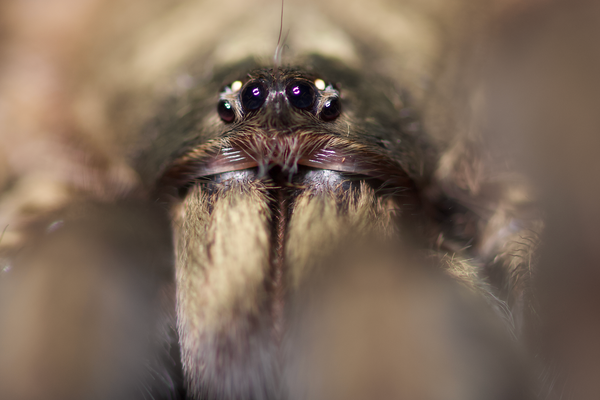

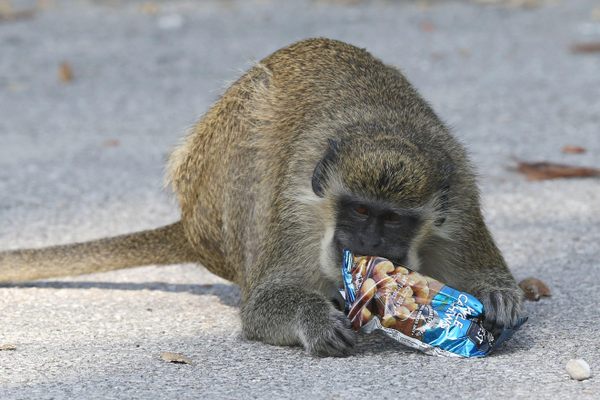
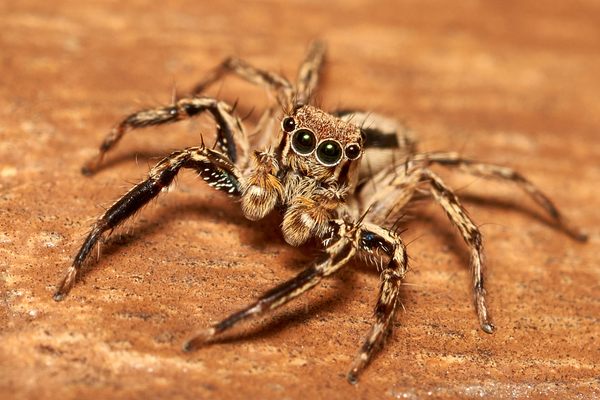










Follow us on Twitter to get the latest on the world's hidden wonders.
Like us on Facebook to get the latest on the world's hidden wonders.
Follow us on Twitter Like us on Facebook